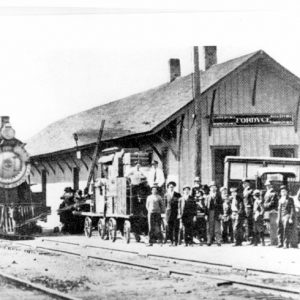calsfoundation@cals.org
Cotton Belt Railroad Depot
Located in Fordyce (Dallas County), the Cotton Belt Depot is a historic railroad building constructed in 1925. Added to the National Register of Historic Places on June 11, 1992, it is located south of the Fordyce Commercial Historic District. The Fordyce Rock Island Depot is located to the northeast of the Cotton Belt Depot, while the Tennessee, Alabama & Georgia Railway Steam Locomotive No. 101 is located just to the west of the building. Both are also listed on the National Register.
The Cotton Belt, officially known as the St. Louis Southwestern Railway, constructed a line in Dallas County in the early 1880s. The town of Fordyce—named for Samuel Wesley Fordyce, who was vice president of the railroad—was established as a stop on the line soon after. Incorporated in 1884, the town relied on the rail industry to transport local agricultural crops to market. The railroad proved to be the key to growth in the town.
The single-story depot building is located north of the tracks and is on an east-to-west axis. Constructed of red brick, the rectangular building is topped with a slate roof and sits on a concrete foundation. A small open loading area is on the east end of the building. The hipped roof was pierced by three brick chimneys at the time of the nomination to the National Register, but by 2013, these had been replaced by modern metal chimneys.
The building includes a telegraph operator’s bay on the southern side, facing the tracks. The southern wall includes four six-over-two windows and a single-leaf door located to the east of the bay. The bay includes a narrow window on the east with two six-over-two windows facing the tracks to the south. The western end of the building facing the tracks includes a large rolling door and another single-leaf door. The northern side of the building includes a number of six-over-two windows and a single-leaf door.
The western end of the building included a large rolling door at the time of the nomination. The eastern end of the building includes two brick columns supporting the hipped roof. Two six-over-two windows look over the loading area.
A ramp was added on the north side of the building, giving access to the northwest corner of the structure. The large rolling door formerly located at this end of the building was replaced by a glass door.
The building’s Mediterranean architectural details include the slate roof, while Craftsman details include elaborate brackets around the cornice and corbelled brick wall brackets.
Empty at the time of the nomination to the National Register, the building was occupied by a coffee shop by 2020. As it has had few modern changes, the building remains much as it did when it operated as a train depot.
For additional information:
“Cotton Belt Railroad Depot.” National Register of Historic Places nomination form. On file at Arkansas Historic Preservation Office, Little Rock, Arkansas. Online at http://www.arkansaspreservation.com/National-Register-Listings/PDF/DA0062.nr.pdf (accessed October 15, 2020).
David Sesser
Henderson State University
 Early Twentieth Century, 1901 through 1940
Early Twentieth Century, 1901 through 1940 Historic Preservation
Historic Preservation Fordyce Train Depot
Fordyce Train Depot 



Comments
No comments on this entry yet.